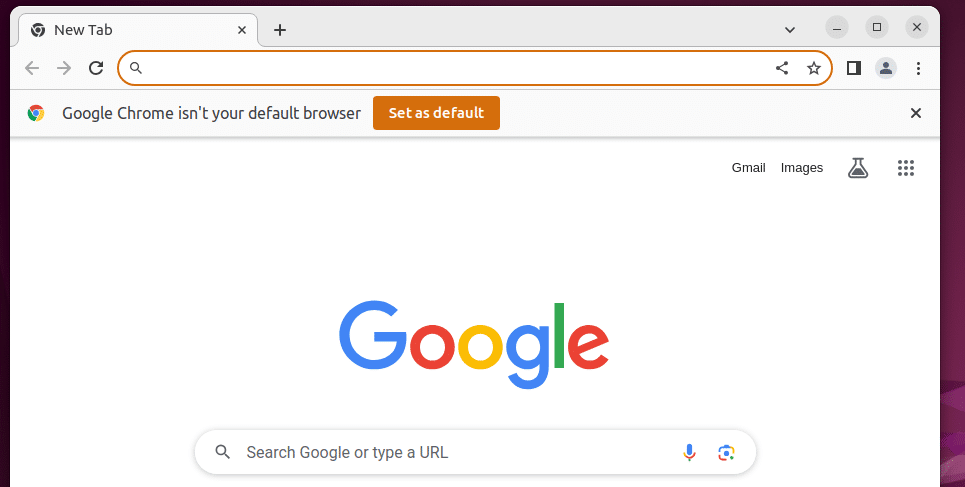How to Install / Update Chrome in Ubuntu (Latest)?

Google Chrome is, without a doubt, one of the most used web browsers in the market. However, Ubuntu doesn’t come with Google Chrome installed, and if you have downloaded the Google Chrome browser, you may have to update it manually.
The default browser that comes with a new installation of Ubuntu is Firefox. However, people have their preferences when it comes to web browsers, and a lot of users prefer using Google Chrome.
This guide will demonstrate the two different ways of installing Google Chrome on your Ubuntu machine and updating it manually.
Table of Contents
Install Google Chrome on Ubuntu Through Terminal
Using the command line or the terminal is the most efficient way of managing your applications and packages in Ubuntu or other Linux-based variants. Google Chrome can be found in Ubuntu’s default apt repository and installed using the apt package manager.
To do this, start by opening a new terminal session (CTRL + ALT + T), update the “apt” packages list, and upgrade available packages by running the following commands:
sudo apt update sudo apt upgrade
Once you have updated the apt packages list, use the apt package manager to install the Google Chrome Stable version on your Ubuntu by running the following command:
sudo apt install google-chrome-stable
You will be prompted to provide the root user’s password. Once you have provided the password, the downloading and the installation process will begin:
Once the process has been completed, you can find Google Chrome in the applications tray:
Click on its icon to launch it from the application and enjoy browsing the internet with Google Chrome on Ubuntu:
You can also choose the unstable version of Google Chrome, which mostly comes with newer features but can be buggy sometimes. To do that, you will have to run the following command:
sudo apt install google-chrome-unstable
Install Google Chrome on Ubuntu Using GUI
If you are not fond of command-line installers or package managers, then you can always use the GUI available in Ubuntu. This is also useful for users who are new to Ubuntu or Linux-based operating systems, as the command line can be quite confusing and daunting at first.
- To install Google Chrome using the GUI, open the Ubuntu Software Center from the desktop.
- Use the search bar in the Ubuntu Software Center to search for Google Chrome.
- Then click on the “install” button next to its name and wait for the installation process to complete.
Note: If you are running an older version of Ubuntu, then you might see Chrome in the Ubuntu Software Center, in that case, you will see “Chromium”.
Update Google Chrome on Ubuntu
If you have previously installed Google Chrome and want to update it manually for any reason, you can do it from the terminal. Before you move on to the update section, it is better to quickly check the Google Chrome version you have installed on your Ubuntu machine. To do this, you will have to run the following command:
google-chrome-stable --version
For the unstable version, you will run the following command:
google-chrome-unstable --version
To update the Google Chrome manually, open a terminal session and run the following commands:
sudo apt update sudo apt upgrade
As mentioned above, these commands will update the package list and find the latest version of the currently installed packages. If there are any updates that are available, then they will be updated due to the second command.
However, this will update all of the packages that have pending updates. If you wish to update only Google Chrome and not the other packages, then you can use the “install” apt command in the following way:
sudo apt --only-upgrade install google-chrome-stable
Once again, if you are using the beta version of Chrome (also known as the unstable version) then you will have to run the following command:
sudo apt --only-upgrade install google-chrome-unstable
Congrats! You have updated only Google Chrome manually on Ubuntu.
Affordable VPS Hosting With Dracula Servers
Looking for reliable and budget-friendly Virtual Private Server (VPS) hosting? Look no further than Dracula Servers. Dracula Servers offers a range of VPS hosting plans tailored to meet diverse needs. With competitive pricing, robust performance, and a user-friendly interface, it’s an excellent choice for individuals and businesses alike.
Explore the Dracula Servers website to discover hosting solutions that align with your requirements and take your online presence to new heights with their affordable and efficient VPS hosting services.
Visit Dracula Servers and experience reliable VPS hosting without breaking the bank.
Uninstall Google Chrome From Ubuntu
If you are not fond of Google Chrome or if it is bugging you, then you can remove it from your system rather than letting it consume storage space.
To uninstall Google Chrome from your Ubuntu system, open up a terminal and execute the following command:
sudo apt --purge remove google-chrome-stable
Once the command has been processed, Google Chrome will be removed from your system completely. However, if you have installed the Unstable version of Chrome, then you will run the following command to uninstall it from your system:
sudo apt --purge remove google-chrome-unstable
Alternatives to Google Chrome on Ubuntu
When considering alternatives to Google Chrome on your Ubuntu system, you have several robust options catering to different preferences and needs.
Mozilla Firefox: Renowned for its commitment to user privacy, Mozilla Firefox stands out as an open-source browser with a user-friendly interface. Its extensive library of extensions allows users to tailor their browsing experience, and advanced privacy features provide a secure online environment. As mentioned above, Firefox comes preinstalled on Ubuntu. Therefore, you don’t need a command to install Firefox.
If you have removed it from your system, then you can use the following command to install it again:
sudo apt update sudo apt install firefox
Chromium: As the open-source project behind Google Chrome, Chromium offers a similar browsing experience without Google’s proprietary features. Known for its speed and efficiency, Chromium supports a wide range of extensions, making it an excellent choice for users who value simplicity and performance.
sudo apt update sudo apt install chromium-browser
Opera: Opera might be the answer if you’re seeking a feature-rich browser focusing on user customization. Beyond its clean interface, Opera boasts a built-in ad blocker, a free VPN service for enhanced privacy, and a convenient sidebar providing quick access to various tools and apps.
sudo apt update sudo apt install opera-stable
These alternatives present diverse features, allowing users on Ubuntu to choose a browser that aligns with their priorities—whether it’s privacy, customization, or integrated tools—for a tailored and satisfying browsing experience.
That is all about this guide!
Wrap up
Chrome is a modern, interactive, and efficient web browser also available for Ubuntu. Even though it isn’t pre-installed on Ubuntu, you can still install it using the apt package manager. If you are new to Linux-based operating systems, you can use the Ubuntu Software Center, which provides a GUI to install packages.
Otherwise, use the apt package manager to update the packages list and then use the “install” command to install either the stable or unstable versions to use the beta features.
If you want to manually update the already installed Google Chrome, then run the apt “update” and “upgrade” commands. Otherwise, you can use the install command with the “–only-upgrade” flag.
Check out More Linux Tutorials Here!
Subscribe
Login
0 Comments
Oldest





